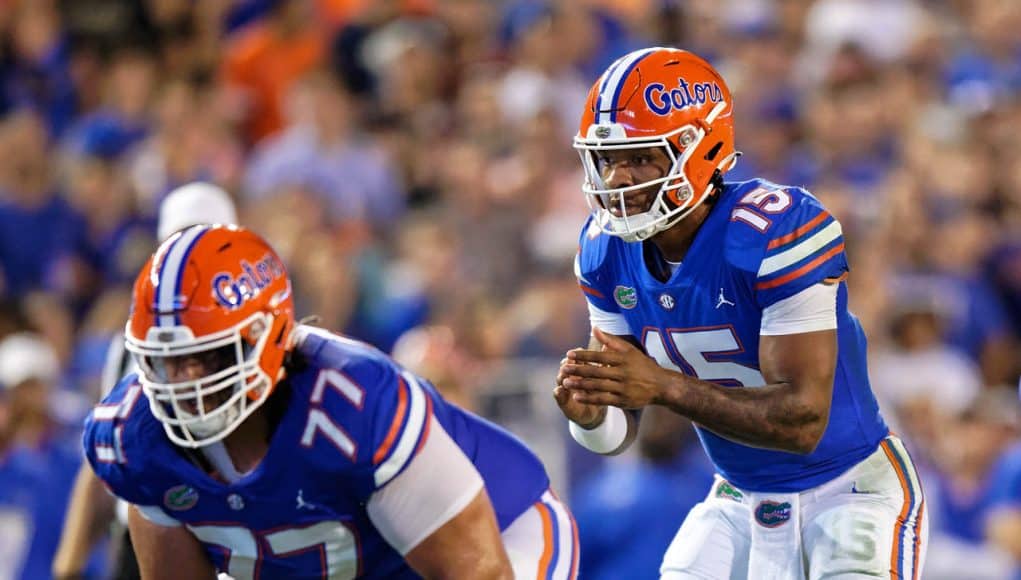Six games in, the Florida football team is still something of a Rorschach test. Last weekend’s game against Missouri did nothing to change that. Were they two missed field goals away from a comfortable win, or two bad Brady Cook passes from an overtime game or loss? The perspective you bring to that question will determine its answer.
There are some things that are unambiguously good about the first half of the first season of the Billy Napier era, however. Here are three of them.
Penalties
I don’t think I’m the first one to point this out this week, but the Gators are in a place they almost never are: near the top of the SEC in fewest penalties.
The Gators are in a virtual tie with Vanderbilt for third in the league in fewest flags per game at 5.3, which is 0.1 per game more than the Commodores. They are up to second in the conference in fewest penalty yards per game at a mere 34.3 per game. Kentucky is ahead of UF in both categories, but the Nos. 2 and 3 teams in fewest flags per game (UGA and Vandy) average more penalty yards than UF does.
Florida has been around here in penalties per game recently; they averaged 5.2 per game in 2019 and 5.3 in 2020. However in both cases, the Gators averaged more than ten penalty yards more per game than this year’s team has done so far.
UF’s best showing yet was last weekend with just one penalty for five yards.
And I know what you’re thinking: how many of these flags came on kickoff returns? The answer is five: two against Utah and one each against UK, USF, and Tennessee. Had UF fair-caught every kickoff so far, they’d have 27 flags in six games for 4.5 per outing. That’d tie them with Kentucky for second in the SEC just behind No. 1 Georgia’s 4.2 per contest.
Sacks allowed
Florida has allowed a very low number of sacks so far this season. They’ve only given up four of them so far, which both in the raw total and in sacks per game ties them for fifth nationally. They’re also second in the SEC behind only Ole Miss and its two sacks allowed. The Rebels, I could add, have played one FCS and two G5 opponents to UF’s one of each, plus a Georgia Tech team that would later fire its coach and Vandy.
Research has shown that sacks are more a quarterback stat than an offensive line stat. You can see that in how the Gators led the conference in fewest allowed with the mobile Emory Jones last year despite the team’s lackluster finish but were middle-of-the-pack with the comparatively lead-footed Kyle Trask the prior two. Line can and does make a difference, but the signal caller makes a bigger one.
That means the sack success is on Anthony Richardson primarily, given that he’s played the large majority of snaps behind center. He’s gone down four times in 149 drop backs for a rate of 2.68%. That drop back count only includes pass attempts and sacks, so if there was an official scramble stat to include, the rate would be even lower.
His one sack against Missouri included a lost fumble, so I’m sure this stat is cold comfort with that being the most recent memory to draw upon. However, the team and AR specifically have done a good job of avoiding sacks so far.
Explosive rushing
If it seems like the Gators break off a lot of long runs, it’s because they do. Those chunk plays on the ground have done a lot of work for the offense, and a rejuvenated approach with a largely zone-based scheme and a couple of new running backs have really energized the offense.
Florida’s totals in the long runs table don’t jump off the page necessarily, but that’s because the Gators have run the second-fewest plays in the league. They’re all of five plays ahead of last-place Texas A&M in totals, and closer at 59.8 plays per game to the Aggies’ 59 even than to 12th place Kentucky’s 62.7 per game. Last week I broke down why UF had low play counts against USF and EWU, and then they had their fewest plays run yet against Mizzou for some of the same reasons.
Once you account for that fact, UF is third in the league in rate of runs of 10+ and 20+ yards. They rise to the top in rate of 30+ yard runs, and they’re tied with Alabama for first in rate of 40+ yard runs.
If you look at individual contributors, there are Gators near the top there too. The figures below have sacks removed from the rushing totals for the quarterbacks.
Alabama backup QB Jalen Milroe is well out in front at a sack-adjusted 10.8 yards per carry, and teammate Jahmyr Gibbs is second at 8.3. Montrell Johnson is right behind in third at an even 8.0 yards per carry, however, in a tie with LSU QB Jayden Daniels once you take out his 19 sacks in six games. Richardson (7.07 YPC) is nearly tied for fifth with Tennessee’s Hendon Hooker (7.16). After Ole Miss QB Jaxson Dart clocks in seventh at a sack-adjusted 7.0 per carry, Trevor Etienne shows up in eighth at 6.8 yards per rush.
So, more than a third of the top eight SEC ball carriers in sack-adjusted yards per rush wear orange and blue. Not too shabby for a first year in a new rushing scheme with an offensive line that lost its starting right tackle relatively early on.


